Gardening tips: when and how to prune an apple tree correctly
Pruning - This is the removal of diseased, damaged and old tree branches, which protects apple trees from diseases and contributes to the normal functioning of the juices. Pruning allows the crown to form correctly. The branches must be shaped so that they are longer at the bottom and shorter at the top. Pruning should be done according to the principle the higher the branch is, the shorter it should be.
Content
- The benefits of pruning an apple tree
- Basic rules for pruning trees
- Formation of seedlings
- Pruning mature trees
- Spring pruning rules and timing
- Rules and terms for autumn pruning
- How to prune branches
The benefits of pruning an apple tree
A well-formed tree provides decorative effect apple trees, and contributes to the endurance of the trunk, the strengthening of the branches and the convenient collection of apples. If pruning is done incorrectly or is absent at all, then there is a risk of deformation and breaking off of the branches under the weight of the fruit. This manipulation has the following goals:
- rejuvenation and strengthening of young branches
- increasing the number of fruitful branches
- forming an advantageous apple tree shape
- prevention of diseases and stopping the reproduction of harmful insects
- freeing the tree from dry and damaged branches
- access to sunlight
- preparation for wintering
Quite often, the pruning procedure allows you to save old trees, and in young ones it provokes growth and increased fruiting.
Basic rules for pruning trees
Pruning apple trees should be done in the first year of planting seedlings. The trees should not be allowed to grow arbitrarily, or the harvest will be poor. The shape of the crown must be constantly adjusted, which will facilitate the maintenance of the garden and increase the quality and quantity of the crop.
Experienced gardeners are advised to adhere to the basic rules for pruning an apple tree:
- The central branch should always be 25-30 cm higher than the other branches of the crown.
- If you need to thin out the inside, pruning is carried out along the bud, which is located on the outside of the crown. And if the inside is scanty and needs to be filled with young twigs, then the bud is left looking inward.
- Young branches are cut by a third. If the pruning is deeper, the crown will thicken, which is not necessary for fruiting.
- The main branches around the central one should be approximately equal in development.
- Wounds heal faster on thinner branches, so pruning should be done annually.
- You can not leave knots from the cuts. Pruning should be carried out on the ring, that is, so that after healing there is a small influx of annular shape.
- Gardening tools must be well sharpened and sterilized.
Formation of seedlings
Correct pruning of young seedlings is the key to good fruiting. The basic condition is cropping seedlings in the spring, regardless of planting time. This allows the tree to direct all its forces towards strengthening and development. root system... Otherwise, the apple tree can direct all efforts to the growth of branches and poorly gain a foothold in the ground, which will make the tree vulnerable and undermine its immunity to diseases.
Saplings are cut to a height of 75-85 cm, leaving 6-9 buds on the trunk. In this case, the crown should rise 16-20 cm above the lateral branches, and the first bud should be at a height of at least 50 cm from ground level.
Such pruning is carried out in the first and second year of the seedlings' life.
In the third and fourth years, the trunk must be freed as much as possible from small twigs and side shoots in order to ensure the flow of light into the inside of the crown. You should also remove the branch growing strictly up or down, and the side branches are freed from small and weak growth.
Pruning mature trees
In mature trees, heavy lateral branches are pruned, forming and thinning the crown apple trees... The branch bent to the ground is left, and the overly elongated ones need to be cut off as mono shorter. Have columnar apple trees leave one main trunk. You can leave several powerful shoots, if such have formed.
In spring pruning, the removed healthy and long shoots can be left for vaccinations for the wild - wild apple trees with small fruits, but with higher characteristics relative to domesticated ones. Interestingly, there are several known cases of grafting apple trees on pears and vice versa. As a result, two trees grow from one trunk: an apple tree and a pear tree.
Young apple trees should be pruned annually in the fall and spring.
Manipulation should take place during a dormant period at a temperature of at least ten degrees: in the fall - after the leaves fall, and in the spring - before the start of sap flow and bud swelling. Spring pruning is aimed at removing branches frozen during the winter period, shaping the tree shape and increasing productivity. Autumn pruning involves preparing the apple tree for wintering. Old and damaged branches are subject to removal. Sometimes pruning is done during the summer and winter months. In the summer, pinching of shoots and thinning of the crown is carried out. In winter, pruning is carried out only in regions with a warm climate, because during frosts, the ora becomes fragile and the risk of damage increases.
Spring pruning rules and timing
Spring pruning is usually done in late March or early April. Input manipulations are deleted:
- branches growing on the inside of the crown
- broken branches and twigs
- shoots interfering with each other and the rest of the tree branches
- weakened twigs that do not form fruit
Spring pruning is directed to thinning and shortening. Thinning begins with the opening of the center, by shortening the central branch with branches, which provides uniform illumination of sunlight.
At the next stage, the thickest parts of the tree are thinned out.
Gardeners advise starting the manipulation by pruning thicker branches, which will set the direction of work and facilitate wound healing. The shortening of the branches stimulates the saturation of the buds with moisture and nutrition.
In addition, this manipulation helps to arrange the apple trees and improve the interior lighting. The lower branches are pruned under the branches directed upwards. If the crown is too thick, it is advisable to break the pruning into stages so that the trees heal from wounds faster.
Rules and terms for autumn pruning
Autumn pruning of apple trees is carried out taking into account two rules: they begin at the end of the leaf shedding and finish before the first frost. If the sections do not have time to heal before frost and freeze, there will be a general deterioration in the condition of the trees.
In autumn, three types of pruning are carried out:
- weak (for young trees), which consists in shortening the branches that have grown since spring by a quarter
- medium (for apple trees over five years old) - shortening by a third of the branches that have grown during the season
- deep (for mature trees) - carried out for the purpose of thinning. The branches that have grown in a year are cut in half
After trimming is complete, you need to process all cuts with a sealing compound.Moreover, such treatment on adult apple trees is carried out immediately after the manipulation, and on young ones - a day later, in order to allow the surface to dry out a little.
With autumn pruning, oxygen and light are available to the main fruiting branches. Removal of affected shoots diseases and pests, stops their spread throughout the garden next spring.
How to prune branches
Dry branches should not be removed near the trunk itself, because the dried stump will soon fall out and form a hollow, which can destroy apple tree... First, they saw the branch along the first bud, and then, using a thin saw with fine teeth, they saw the branch so that the saw cut looked towards the cut branch.
The processing of such cuts should be carried out with a garden varnish, which can be purchased at a specialized store.
Prune young apple trees with thin branches with pruning shears, and thicker and stronger branches with a saw. The tool must be well sharpened and sterile. When using blunt equipment, the procedure can loosen the bark, which will slow down wound healing.
For the processing of sections, it is recommended to use oil paint based on drying oil, a disinfecting lime solution with copper sulfate in a ratio of 10: 1 and garden var.
More information can be found in the video:



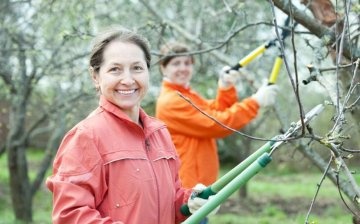
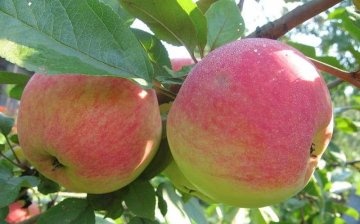
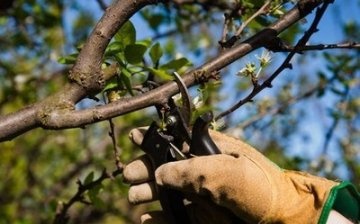
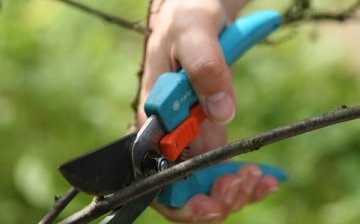
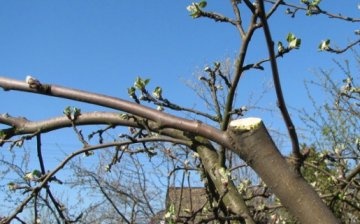

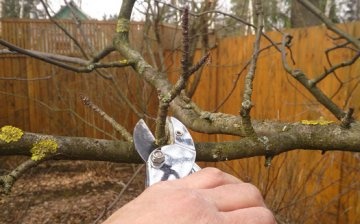









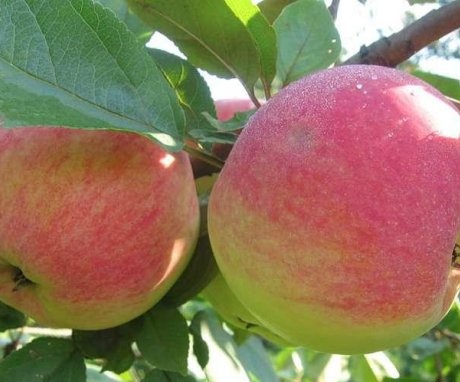
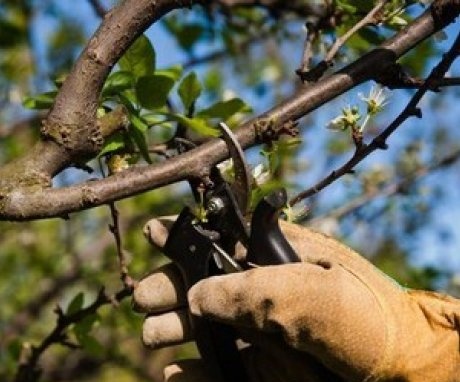
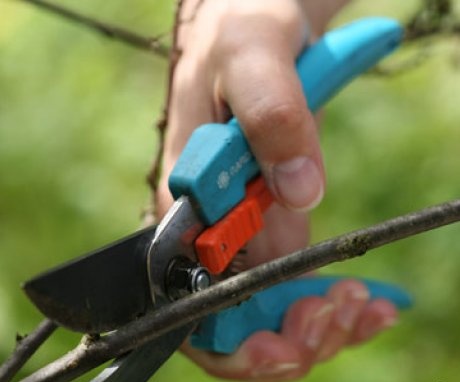
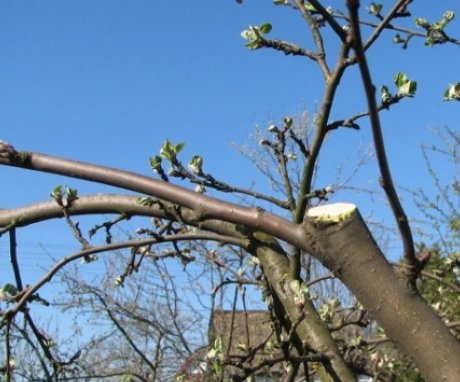
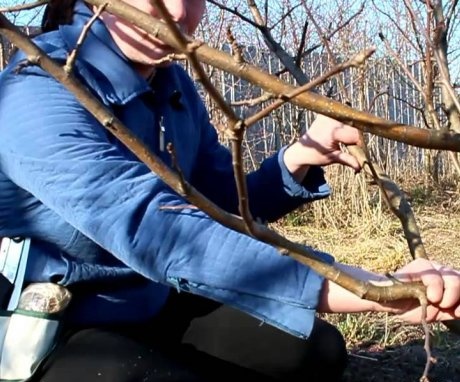
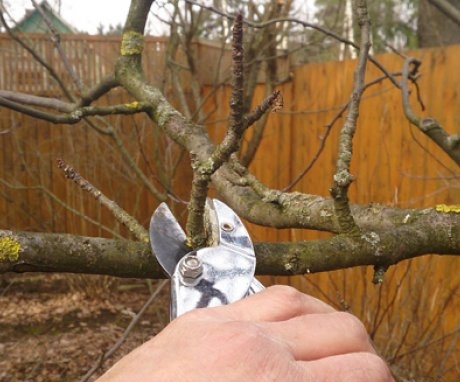
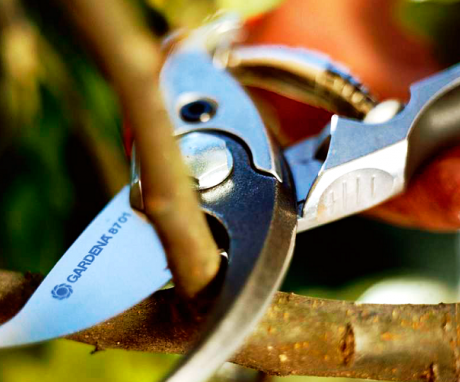
They sawed off a large branch from the apple tree in the spring, since it was very heavy. The section was waxed. Later, the apple tree began to bloom, there were a lot of flowers, and accordingly a lot of apples were harvested. I think, having freed the apple tree from its weight, she thanked us with a big harvest.
When pruning the crown of an apple tree, it must be borne in mind that most apples grow on branches that are located horizontally. Therefore, if possible, it is better not to touch them. In addition, some branches, on the contrary, with the help of a strong rope, can be pulled to a horizontal position. The yield and size of apples, however, will be larger.
It is necessary to prune an apple tree especially when it is younger, because it is at this time that its shape is formed; at an older age, pruning is necessary to remove wilted branches.